Going Green
|
Change a light bulb A lot of people are touting the benefits of compact fluorescent lighting (CFL), because it uses a lot less power. But a lot of people are sensitive to fluorescent. Plus it contains the toxic metal mercury, so please dispose of them properly at your local Home Depot. I personally prefer full spectrum bulbs and LED bulbs. LEDs use 80-90% less energy & can last 100,000 hours, which means much lower electric bills. |
|
|
Get those leaks fixed. Did you know that an unassuming leaky faucet can waste 3 gallons of water a day? That’s 27 bathtubs a year! So call the plumber or do it yourself; you’ll save money in the long run. |
 |
|
Update your shower head. Did you know that your old shower head spews more than twice as much water as the more recent models? For a relatively low cost you can get an eco-friendly shower head that cuts water flow to around 1.6 gallons per minute. You won’t be able to tell the difference and you’ll save 40 percent on your water bill! |
 |
|
Unplug Everything! Sad but true: our household electronics are eating up power even when the power button is off. If you have a TV, DVD player, and a computer, you could be spending 200 dollars a year pumping wasted electricity into those devices while they are off. So make it a habit and unplug everything! |
 |
|
Buy local. You’re guaranteed to have a smaller impact on the environment and the food tastes better! Check out these great websites to learn more about the local food movement: www.localharvest.com, www.locavores.com, www.foodroutes.com, www.slowfoodusa.com |
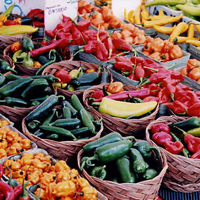 |
|
Buy organic. Not only does buying organic help save the planet, but you simply cannot get the same nutrient value from regular produce as you do from toxin-free organic food. For everything you buy organic you’re preventing disease and adding years to your life, and that’s worth it. |
 |
|
Go vegan! At least a little bit… Did you know that if you replaced 2 or 3 meat filled meals a week with a vegetarian alternative you’ll be greatly contributing to the reduction of greenhouse gases? Nearly 20 percent of greenhouse gases come from livestock.Overly broad shrimp nets can catch in excess of 5 times the amount of unwanted sea creatures for every pound of shrimp. Or what about the cattle who live ankle deep in their own manure and urine? So please, if you’re going to eat meat: buy locally raised, organically certified, free range. |
 |
|
Bring your own bag to the grocery store. You’re doing this already, right? Well let me offer a little bit of encouragement: 1 ton of bags = 11 barrels of crude oil, and each bag produces 1.2 pounds of pollution and only 1% of plastic bags get recycled. |
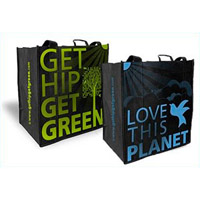 |
|
Did someone say recycle? In California alone, some 3 million plastic bottles still go unrecycled. That’s every day! Remember, every bottle you don’t recycle either gets put into a landfill, or is incinerated releasing toxic fumes into the air. If recycled, those 3 million bottles could be used to make 74 million square feet of carpet-or 16 million sweaters. |
 |
|
Check out the labels on your coffee. What if Americans got their 400 million cups of coffee each day through responsible growers? Look for labels that read “shade grown,” or “bird friendly” to promote optimal habitats, and always go for 100 percent organic “free trade” coffee. Make a statement, bring your own mug to your local coffee shop. |
 |
|
Burn calories instead of fuel. Ride your bike, walk, run; however you get there, see if you can do it without a car. Burning a single gallon of gas produces 20 pounds of carbon dioxide, which contains five pounds of pure carbon. Walk a mile a day? You’ll lose ten pounds of fat a year and save almost 400 pounds of carbon! |
 |
|
If you can, get an electric car. Vehicles consume half the world’s oil and spew a quarter of its greenhouse gas emissions. The average car emits 12,000 pounds of carbon dioxide each year. |
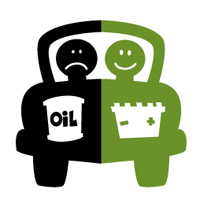 |
|
Buy vintage clothes. Buying vintage clothes helps save the environment! Cotton crops account for 10% of pesticide use and nearly 25% of herbicide use. Plus, they’re stylish and thrifty! |
 |
|
Plant a tree. Go to www.plantabillion.org and make sure our grandchildren are getting enough oxygen. Trees help by taking in CO2 and converting it to oxygen, thus reducing global warming. |
 |
|
Inflate your tires. Did you know that having low tire pressure is bad for the environment? Filling up your tires can improve gas mileage by 3.3 percent. |
 |
|
Use non-toxic paint. Due to household chemicals and toxic paints, the air inside your home can be three times more polluted than the air outdoors. For your next home improvement project, try using a paint free of toxic chemicals. Go to www.mythicpaint.com, www.ecospaints.com, and eartheasy for more information. |
 |
|
Make your own non-toxic cleaning products. Did you know you could save money and the environment by making your own cleaning products? Find recipes here. For larger scale operations (hospitals, schools, offices, industries) a new form of electrolyzed water that is so powerful it can kill anthrax and so safe you can drink it. No joke. |
 |
|
|
|
|
Your harshest cleaning jobs don’t need harsh chemicals. “Heavy duty” cleaners are filled to the brim with chemicals that are poisonous for the environment and your family. As an alternative, try cleaning your oven with an overnight application of water and baking soda paste. You can clean the toilet bowl by pouring one cup of borax in at night, then scrub and flush the next morning. |
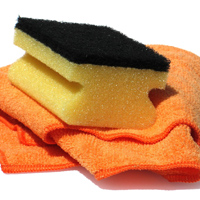 |
|
Baking soda: The world’s best odor eater. Some people love the sensation of Mountain Mist and Spring Lilac searing their nostrils and lungs, but the truth is chemical fragrances are dangerous. For a do-it-yourself solution, try mixing 1 teaspoon baking soda with 1 teaspoon lemon juice in two cups of water and pouring the mixture into a spray bottle. |
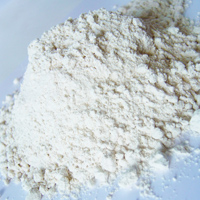 |
|
Improve your consumer karma. Be on the lookout for safe and sustainable products for your home. For some of the best non-toxic items on the market, check out these websites: www.bioshieldpaint.com, www.ecos.com, www.ecover.com, www.naturallyyoursclean.com, www.seventhgen.com, www.simplegreen.com. |
 |
|
When it comes to beauty products, non-toxic is the only way to go. Benzoates? Cocamide? Phthalates? If you can’t pronounce it, you probably shouldn’t be putting it on your face. Go to www.thevitalimage.com to find some of my favorite organic non-toxic products. |
 |
|
Recycle your beauty products. Take any of your used MAC beauty products back to the counter so they can be responsibly recycled. And you get a free lipstick! Go here to find out more. |
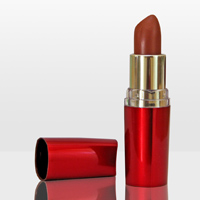 |
|
Calculate your footprint. Found out the impact you’re really having on the environment at www.nature.org. |
 |
